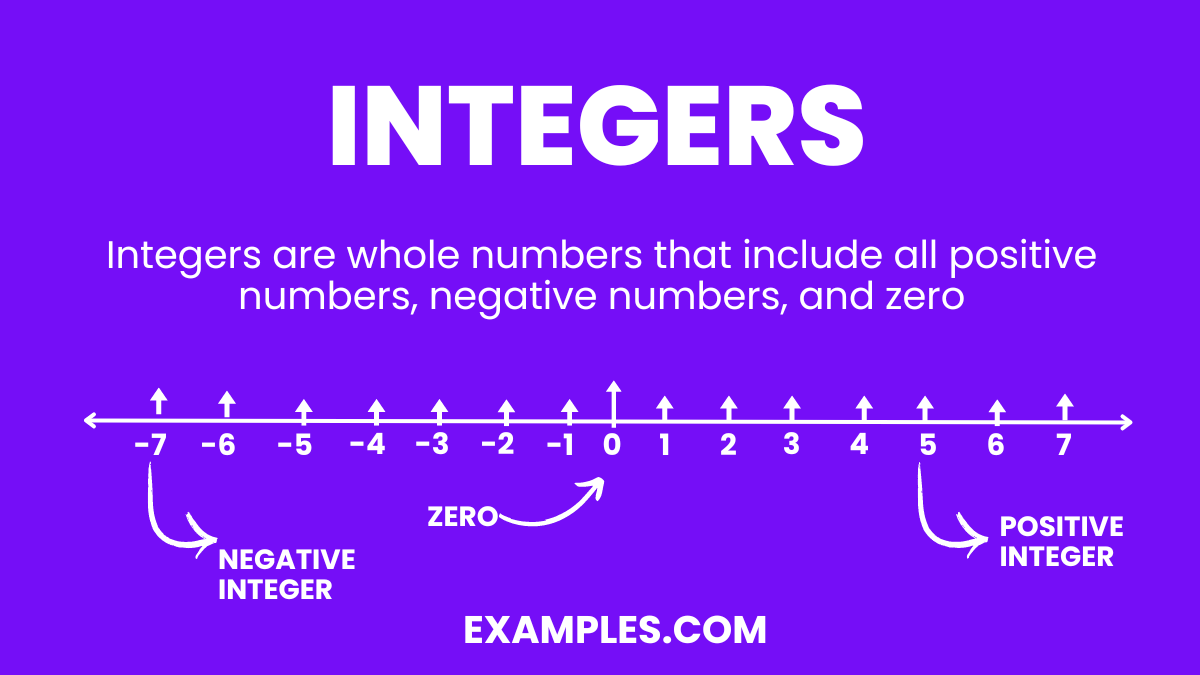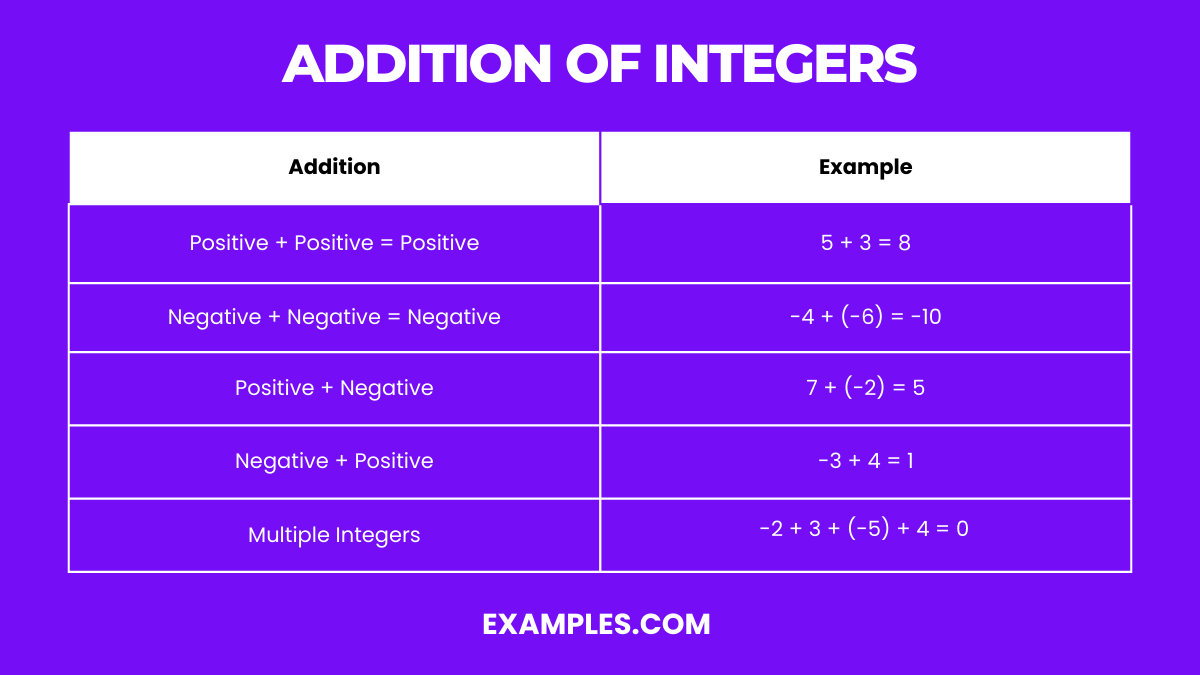What is the result of −7+3?
-10
-4
4
10

The world of integers, the building blocks of arithmetic. This guide is meticulously designed to demystify integers for both educators and students, presenting concepts in clear, simple English. From understanding basic definitions to exploring complex operations, our examples illuminate the path to mastering integers. Ideal for classroom instruction, this resource aids in breaking down mathematical barriers, fostering a supportive learning environment where students can thrive in their numerical literacy journey.
Integers are whole numbers that include all positive numbers, negative numbers, and zero. This set does not include fractions or decimals. Integers are fundamental in mathematics, allowing us to perform various arithmetic operations and understand concepts like positive and negative values.
A standout example of integers in real life is temperature, especially when it dips below zero. Representing temperatures as integers, such as -10°C for a chilly winter day, illustrates how these numbers can be used to describe conditions in the environment, showcasing the practical application of negative values.
Integers encompass the set of whole numbers including positive numbers, negative numbers, and zero. This range makes integers indispensable for various mathematical calculations and real-life applications. Understanding the different types of integers equips students with the tools needed for arithmetic operations, algebra, and beyond, enhancing their mathematical literacy and problem-solving skills.
The classification of integers is a fundamental concept in mathematics that organizes integers into distinct categories based on their properties. This classification helps in simplifying mathematical operations and understanding the underlying patterns within the number system. It is crucial for students to grasp these categories to navigate through more complex mathematical concepts effectively.
The set of integers is a complete collection of whole numbers comprising positive numbers, negative numbers, and zero. This set is symbolized by the letter Z and forms the basis for arithmetic and algebra. Understanding the set of integers is crucial for students to develop a comprehensive mathematical foundation, enabling accurate computation and logical reasoning in everyday scenarios.
Placing integers on a number line is a visual method to understand their value and relationship with each other. This approach demystifies the concept of positive and negative numbers, offering a clear, intuitive understanding of their sequence and spacing. Ideal for educational settings, it aids students in grasping the basics of number theory, enhancing their numerical communication skills with practical, visual examples.
Graphing integers on a number line is an effective tool for visualizing and comparing numbers. It simplifies complex concepts, such as ordering and absolute values, into straightforward, easily digestible visual information. This technique is particularly valuable in teaching scenarios, enabling students to better conceptualize mathematical principles and apply them in various contexts.
Integer operations include addition, subtraction, multiplication, and division, each following specific rules that govern the arithmetic of whole numbers. Understanding these operations is crucial for students, as they form the foundation of mathematical problem-solving and logical reasoning. This knowledge equips learners with the skills to tackle more complex equations and real-life mathematical scenarios.

Mastering the addition of integers is essential for navigating through mathematical concepts, from basic arithmetic to complex algebra. This guide introduces the foundational steps and rules, making it easier for students to understand how positive and negative numbers combine, enriching their arithmetic skills and confidence.
The addition of integers follows simple rules that ensure accuracy in calculation. Understanding these rules helps students correctly assess the sum of positive and negative numbers, enhancing their problem-solving skills.
Subtraction of integers involves specific rules that help in determining the result of combining positive and negative numbers. Understanding these rules is crucial for accurately performing mathematical operations and solving problems. Here’s how these rules apply to the subtraction of integers:
Subtracting a smaller positive integer from a larger positive integer results in a positive difference, as the overall value decreases but remains positive. For example, 8−3=5. However, if the smaller number is subtracted from the larger one, the result is negative, such as 3−8=−5, reflecting a decrease beyond zero.
Subtracting a negative integer from another negative integer where the minuend is less negative than the subtrahend results in a positive difference, such as (−3)−(−7)=4, since removing a negative is akin to adding a positive. If the minuend is more negative, the result is negative, like (−7)−(−3)=−4, as the value decreases further.
Subtracting a negative integer from a positive integer increases the overall value, resulting in a positive difference. This is because subtracting a negative is the same as adding its absolute value, such as 7−(−2)=9.
When a positive integer is subtracted from a negative integer, the overall value decreases, resulting in a larger negative difference. This reflects further movement away from zero on the number line, such as (−3)−4=−7.
Subtracting several integers involves applying the rules sequentially, taking into account the sign of each integer and its effect on the total value. For example, (−2)−3−(−5)−4=−4, demonstrates the combined effect of subtracting both positive and negative integers from an initial value.
These rules for the subtraction of integers simplify the process of dealing with positive and negative numbers, allowing for straightforward calculations and problem-solving in mathematics.

Multiplication of integers extends the concept of addition by focusing on repeated addition. It’s vital for students to grasp these rules to effectively engage with various mathematical operations and real-life applications.
Understanding the rules of integer multiplication allows students to navigate through calculations with ease, fostering a deeper comprehension of mathematical operations.
Division of integers is akin to multiplication but involves distributing a total into equal parts. It’s crucial for understanding fractions, ratios, and proportional reasoning.
The division of integers follows specific rules that mirror those of multiplication, guiding students through calculations involving division by positive and negative numbers.
Integers embody a rich tapestry of mathematical properties that facilitate various operations. These include the commutative, associative, and distributive properties for addition and multiplication, along with the existence of additive inverses and identity elements. Understanding these properties is crucial for grasping the fundamental concepts of arithmetic and algebra, making integers a pivotal topic in math education.
Representing integers on a number line is a visual method to illustrate the position of integers in relation to each other. This approach helps in understanding the concept of magnitude, the difference between positive and negative integers, and their relative distances from zero. It’s a foundational skill in mathematics, aiding students in visualizing and comprehending integers’ behavior and relationships.
Integers find extensive applications in various fields, reflecting their importance beyond the classroom. From representing real-world quantities to encoding information in computer science, integers form the backbone of numerous practical and theoretical domains, underscoring their ubiquity and utility in everyday life and advanced scientific research.
In conclusion, integers encapsulate a fundamental aspect of mathematics, bridging simple counting with the complex realms of algebra and beyond. Through exploring their properties, representations, and wide-ranging applications, this guide illuminates the integral role integers play in both educational settings and real-world scenarios. Tailored for educators and students, it aims to demystify integers, fostering a deeper understanding and appreciation of this essential mathematical concept.
Text prompt
Add Tone
Types of Integers
Classification of Integers
What is the result of −7+3?
-10
-4
4
10
What is −8 × 6?
-48
-14
14
48
Which of the following is the additive inverse of 9?
-9
0
9
18
What is the result of 12−(−5)?
7
-7
17
-17
What is −15 ÷ 3?
-5
-3
3
5
Which number is not an integer?
-4
0
2.5
10
What is the result of 7 + (−9)?
-16
-2
2
16
What is (−6) × (−4)?
-24
-10
10
24
What is the result of −9 + 9?
-18
-9
0
18
What is 20 ÷ (−4)?
-5
-4
4
5
Before you leave, take our quick quiz to enhance your learning!

